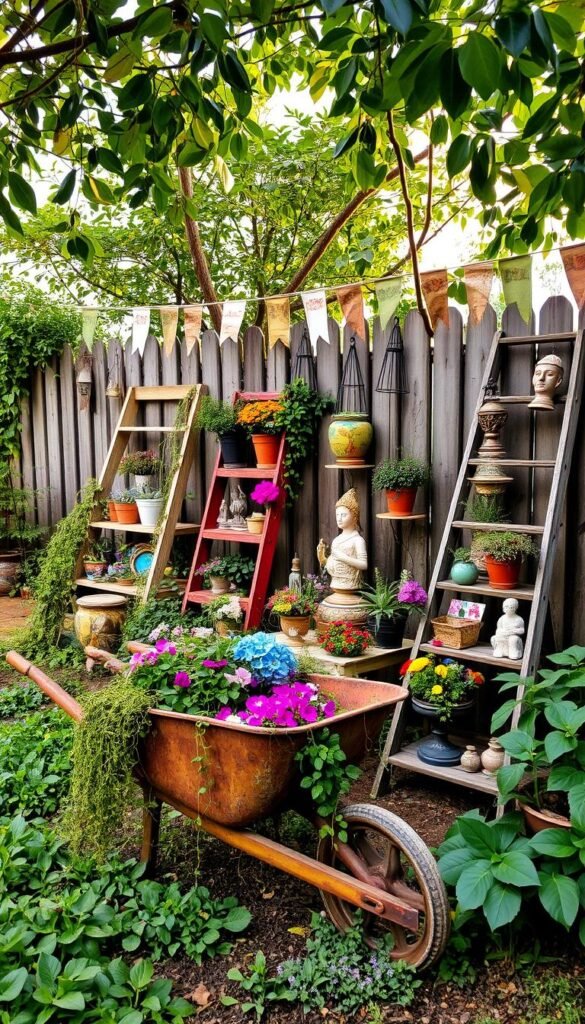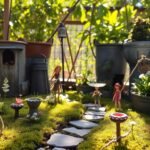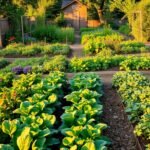Your backyard can become a canvas for creativity with just a little imagination. Instead of tossing out everyday objects, why not repurpose them into eye-catching decor? This approach not only saves money but also reduces waste, making it a win-win for you and the planet.
Research from Oklahoma State University shows how simple transformations can turn overlooked items into stunning features. Think rusty buckets as planters or wooden pallets as vertical gardens. The possibilities are endless when you see potential where others see junk.
More Americans are embracing sustainable landscaping practices. By giving old materials a second chance, you create a space that reflects your personality while minimizing your environmental impact. Your outdoor area can tell a unique story through these clever reinventions.
Ready to explore how ordinary finds can become extraordinary accents? Let’s dive into practical ways to craft your own trash treasure without breaking the bank.
Why Upcycling Is the Perfect Touch for Your Garden
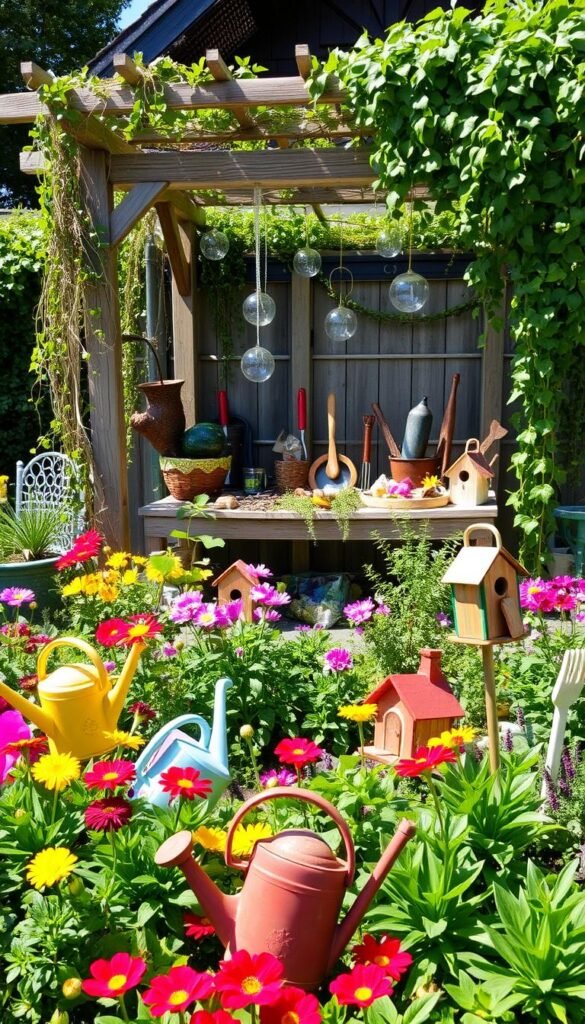
Sustainability meets style when you repurpose materials creatively. Giving old items new life isn’t just eco-friendly—it adds personality to your space. Research shows this approach helps reduce landfill waste while sparking innovation.
Reducing Waste While Boosting Creativity
Oklahoma State University found that 85% of household items can be reused. Instead of tossing them, turn jars into lanterns or pallets into planters. Each project shrinks your environmental footprint and showcases your unique vision.
How Upcycling Saves Money and Resources
Store-bought decor adds up fast. A DIY planter from an old bucket costs pennies, while retail versions run $20–$50. Reusing materials also conserves resources like wood and metal, cutting demand for new production.
| Item | Upcycled Cost | Store Price |
|---|---|---|
| Wooden Planter | $5 (salvaged crate) | $35+ |
| Hanging Lights | $3 (mason jars) | $25+ |
Manufacturing new products consumes energy, but repurposing skips this step entirely. For example, upcycling glass jars into rustic charm lanterns avoids the emissions from melting raw materials.
These solutions prove that small changes make a big impact. Your garden becomes a testament to both creativity and care for the planet.
10 Creative Upcycling Ideas for Your Garden
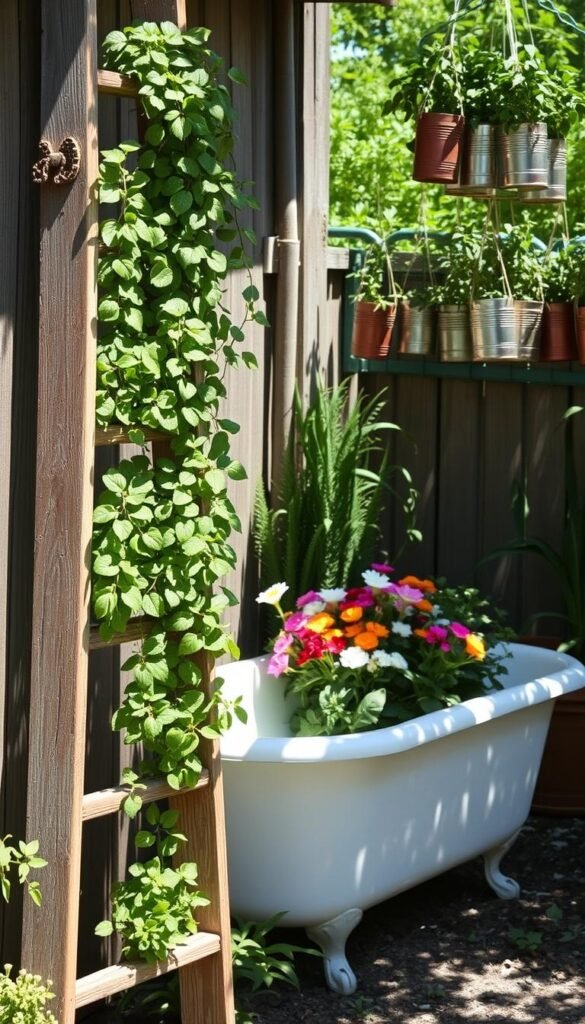
Breathing new life into discarded materials can transform your outdoor space. These clever projects blend functionality with artistic flair, turning everyday items into stunning garden features. Let’s explore five standout ideas that combine practicality with personality.
Furniture Turned Planters
Old dressers and cabinets make perfect plant containers. OSU experts recommend a minimum 4–6″ soil depth for healthy roots. Remove drawers slightly to create tiered planting levels, and always drill drainage holes. Sand rough edges to prevent splinters, then seal with outdoor-safe paint.
Glass Jar Lanterns
Mason jars become magical when hung as lanterns. Use a diamond-tip drill to create drainage holes at the bottom. Fill them with fairy lights or candles, and group them at varying heights for a whimsical glow. For extra style, paint the exteriors with weather-resistant colors.
Pallet Vertical Gardens
Wooden pallets offer instant vertical planting space. Line them with landscape fabric to hold soil, then add succulents or herbs between the slats. Sand thoroughly and apply a wood preservative to prevent rot. This budget-friendly solution maximizes small areas beautifully.
Ceramic Mosaic Paths
Broken plates and tiles create dazzling walkways. Arrange colorful shards in cement or mortar, pressing them firmly into place. The irregular shapes add texture while preventing slips. Thrift stores often sell mismatched dishware perfect for these DIY masterpieces.
Tire Flower Beds
Stack painted tires to form vibrant planters. Use outdoor acrylics in bold hues, and drill drainage holes in the bottom layer. These durable containers withstand harsh weather while adding playful pops of color. Consider planting drought-resistant species for low-maintenance charm.
| Project | Key Materials | Time Required |
|---|---|---|
| Furniture Planter | Old dresser, soil, plants | 2–3 hours |
| Jar Lanterns | Mason jars, drill, lights | 1 hour |
| Pallet Garden | Wooden pallet, fabric, soil | 4 hours |
“The best projects marry creativity with conservation—each repurposed piece tells an environmental success story.”
These ideas prove that with imagination, even the most ordinary objects can become extraordinary garden accents. Which one will you try first?
From Trash to Treasure: Upcycling for a One-of-a-Kind Garden Aesthetic
Ordinary objects can transform into extraordinary garden features. With some imagination, that chipped teacup becomes a bird feeder, and a rusty bicycle wheel turns into a stunning trellis. Oklahoma State University’s research shows how ice-damaged tree stumps make perfect natural planters—proof that beauty often hides in plain sight.
The Magic of Transformation
Witnessing an old bathtub become a pond illustrates this creative process. After cleaning and sealing, the tub gets buried halfway for stability. Add aquatic plants and a small pump, and suddenly you have a water feature that cost under $50. These projects give discarded items new life while adding personality to your space.
Unexpected Items With Hidden Potential
Some objects surprise people with their versatility:
- Vintage typewriters as succulent planters
- Rotary phones converted into quirky birdhouses
- Muffin tins turned into multi-port feeders
- Glass bottles transformed into garden edging
Local Oklahoma gardeners have documented amazing before-and-after changes. One project turned broken ceramic tiles into a dazzling mosaic pathway, while another created twig sculptures from storm debris.
“Creative reuse satisfies our need to make meaning from ordinary things—it’s therapy with tangible results.”
The psychological benefits are real. Repurposing items boosts problem-solving skills and provides accomplishment. As you explore DIY garden art, you’ll start seeing potential everywhere. That cracked salad bowl? Perfect for herbs. Those worn-out boots? Ideal flower containers.
Your garden becomes a gallery of personal treasures, each with its own story. The key lies in looking beyond an object’s original purpose to discover what it could become.
Materials You Can Upcycle Right Now
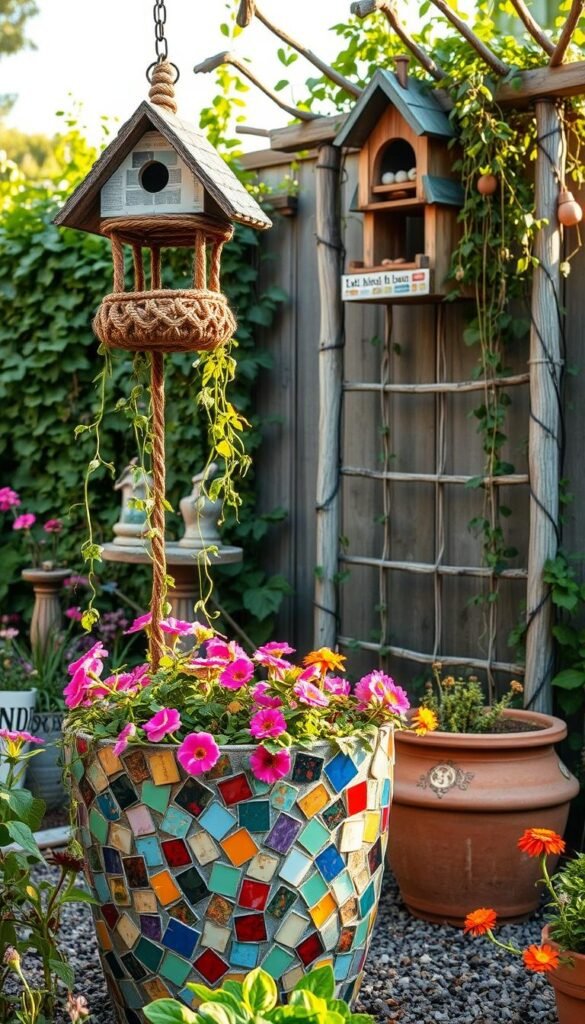
Your home likely holds hidden gems waiting for a second act in your outdoor space. With a little creativity, wooden crates, metal buckets, and plastic containers can become functional art. Oklahoma State University suggests burlap-wrapped pots for heat insulation—just one way to repurpose with purpose.
Wooden Items: Crates, Ladders, and Drawers
Old wood furniture adds rustic charm. Sand rough edges to avoid splinters, and seal with outdoor paint for durability. Check for structural integrity—drawers make tiered planters, while ladders become vertical herb gardens. Pro tip: Avoid pressure-treated wood for edible plants.
Metal Objects: Buckets, Cans, and Tools
Rescued from the trash heap, metal gains new life with rust-resistant spray paint. Drill drainage holes in cans for succulents, or hang vintage tools as quirky hooks. OSU notes that galvanized containers reflect heat, protecting roots in Oklahoma summers.
Plastic Containers: Bottles, Tubs, and Bins
Plastic bottles or bins thrive outdoors with UV-resistant coatings. Cut them into self-watering planters or stackable storage. For stability, fill the base with gravel. These materials create new purpose while reducing waste.
- Safety first: Wear gloves and goggles when sanding or drilling.
- Local finds: Oklahoma thrift stores often stock unused materials.
- Weight limits: Reinforce large containers with additional supports.
“The best upcycles blend practicality with storytelling—each piece carries history into your garden’s future.”
Practical Tips for Successful Upcycling
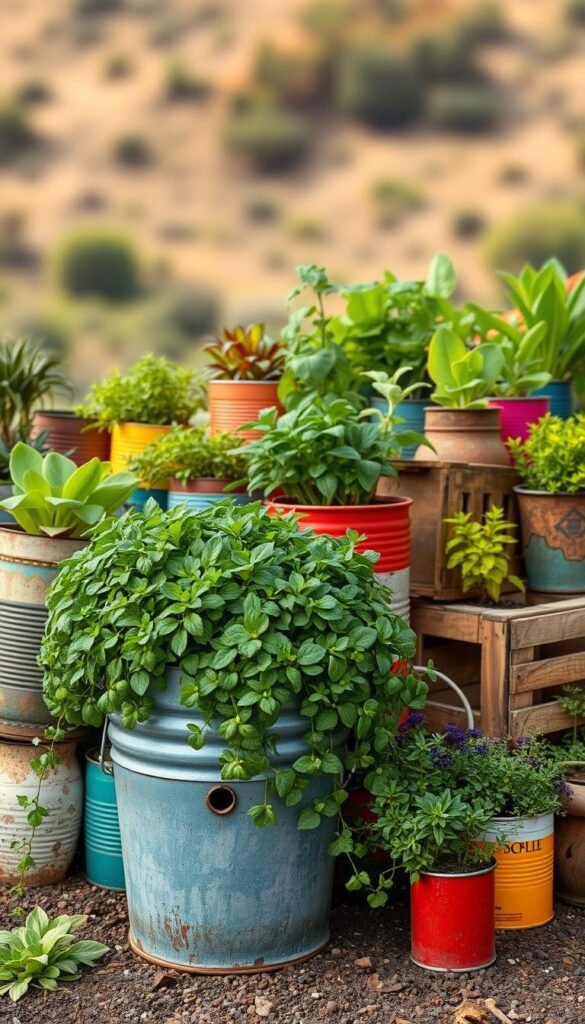
Smart techniques can turn your repurposed projects into thriving green spaces. Whether you’re using old buckets or wooden crates, these strategies ensure your creations last and look stunning.
Drainage: The Foundation of Healthy Planters
Proper drainage prevents root rot and keeps plants happy. Drill holes based on your container’s material:
- Plastic: 1/4″ bit (prevents cracking)
- Metal: 3/16″ bit (use slow speed)
- Ceramic: Diamond-tip bit (add water while drilling)
OSU research shows well-drained soil reduces water consumption by 20%. Layer gravel at the base for extra protection.
Heat-Resistant Plants for Tough Summers
Oklahoma’s Zone 7a summers demand tough choices. These drought-tolerant plants thrive in repurposed containers:
- Sedum (Stonecrop)
- Lantana
- Portulaca (Moss Rose)
- Yucca
Pro tip: Group plants with similar water needs to simplify care.
Insulation: Shield Roots from Extreme Temperatures
Wrap planters with burlap or rope to buffer temperature swings. OSU studies found this cuts summer water use by 30%. For metal containers, line interiors with bubble wrap before adding soil.
“Insulated containers extend growing seasons and reduce stress on plants—key for sustainable gardening.”
Mix soil with 30% perlite for better aeration in sealed containers. Seasonal maintenance like checking for rust or cracks ensures long-term success. Ready to explore step-by-step tutorials? Your garden’s potential is limitless.
The Environmental Impact of Upcycling
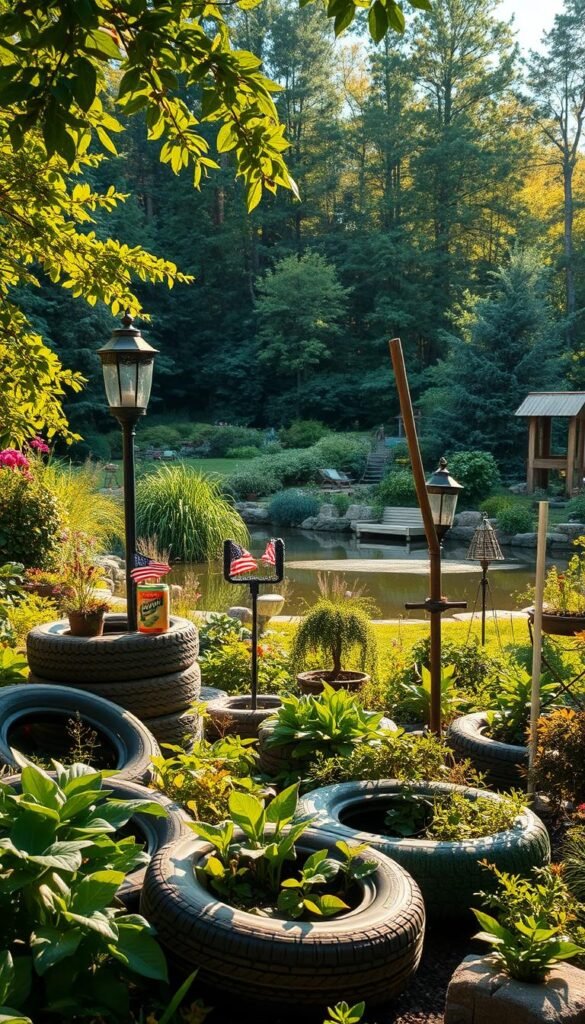
Every repurposed item in your yard makes a difference beyond aesthetics. The EPA estimates creative reuse helps reduce CO2 emissions by 2.5 tons per household annually. That cracked planter or salvaged bench actively fights climate change while beautifying your space.
Breaking Down Landfill Waste
Common garden materials take centuries to decompose naturally. By giving them new purpose, you divert waste from overcrowded landfills. Oklahoma City’s Green Initiative reported a 17% drop in construction debris after promoting reuse programs.
| Material | Decomposition Time | Upcycled Alternative |
|---|---|---|
| Plastic Bottles | 450 years | Self-watering planters |
| Wood Pallets | 10-15 years | Vertical herb gardens |
| Glass Jars | 1 million years | Hanging lanterns |
Your Carbon Footprint Shrinks Here
Manufacturing new products consumes energy equivalent to powering 18 million homes yearly. When you repurpose, you skip this entirely. Oklahoma gardeners saved 3,200 tons of carbon last year by using salvaged materials instead of buying new.
- Plastic repurposing prevents microplastic pollution in waterways
- Upcycled metal requires 75% less water than new production
- Local projects like Tulsa’s Scrap Exchange cut transportation emissions
“Each upcycled item is a vote for cleaner air and healthier soil—your garden becomes part of the solution.”
These efforts add up. If every Oklahoma household repurposed just five items annually, we’d eliminate 12,000 tons of waste. Your creativity literally redefines what’s possible for our planet.
Upcycled Garden Art: Adding Whimsy to Your Space
Transform forgotten objects into eye-catching focal points that spark joy. With simple techniques, you can craft unique art pieces that reflect your personal style. Oklahoma State University workshops reveal how safe metal treatments and creative touches turn salvaged materials into conversation starters.
Metal Sculptures Without Welding
Create stunning sculptures using basic tools and patience. Soak metal pieces in vinegar-water solutions for 48 hours to develop rustic patinas naturally. For stability, embed rebar into concrete bases before arranging your design. OSU experts recommend these no-weld alternatives:
- Twist copper wire around joints for secure connections
- Use epoxy putty for permanent bonds on clean surfaces
- Try plumbing clamps for adjustable industrial looks
Seal finished pieces with rust-resistant spray paint in matte or glossy finishes. This protects your work while letting the metal’s texture shine through.
Tool Markers With Personality
Old rakes and shovels become charming plant identifiers. Clean tools thoroughly, then apply weather-resistant paint using stencils for crisp lettering. For a flea market find vibe, leave some rust as intentional decor.
Pro tips for lasting markers:
- Use chalk paint for easy distressing effects
- Seal wooden handles with linseed oil annually
- Group tools by color for visual impact
Kitchenware Wind Chimes
Turn silverware and colanders into melodic garden accents. Vary lengths of fishing line to create pleasant tones when pieces collide. For best results:
- Choose lightweight metals like aluminum for clearer sounds
- Space items 3-4 inches apart to prevent tangling
- Add beads between pieces for visual rhythm
Hang your creation under eaves to catch gentle breezes. The soft clinking adds a magical touch to outdoor spaces.
“Garden treasures aren’t found—they’re made through imagination and willing hands.”
Your journey into repurposed art begins with seeing potential in everyday objects. Whether crafting rustic farmhouse pieces or industrial chic accents, each project tells a story. What will your next creation reveal?
Upcycling for Small Spaces: Balcony and Patio Ideas
Limited outdoor space doesn’t mean sacrificing style—repurposed items can turn even the tiniest balcony into a lush retreat. Oklahoma State University trials show vertical pallet gardens yield 2lbs of veggies per sq ft, proving creativity beats square footage.
Vertical Gardens From Repurposed Materials
Old pallets or shutters become instant green walls. Secure them vertically and line with landscape fabric before adding soil. For stability:
- Anchor to railings with heavy-duty zip ties
- Use lightweight soil mixes (coconut coir + perlite)
- Group herbs like thyme and oregano for easy harvesting
This budget-friendly solution maximizes every inch without clutter.
Compact Planters From Tin Cans and Shoes
Turn quirky finds into functional containers. Drill drainage holes in sneakers or boots, then fill with drought-tolerant sedum. For tin cans:
- Sand sharp edges and paint with outdoor acrylics
- Stack vertically on a rod for a space-saving herb tower
- Use colanders as hanging strawberry planters
“Small-space gardening thrives on reinvention—each repurposed piece adds charm while solving practical challenges.”
Weight distribution matters on balconies. Place heavier items like pallet gardens against load-bearing walls, and opt for lightweight materials like plastic bottles for hanging installations. Your petite paradise awaits!
Where to Find Upcycling Materials
Hunting for unique materials can be as exciting as the projects themselves. Oklahoma offers countless opportunities to discover hidden gems. Whether you prefer hands-on shopping or digital hunting, these sources deliver quality finds without straining your budget.
Treasure Hunting at Thrift Stores and Flea Markets
Local thrift shops often stock perfect project starters. Look for wooden crates, metal containers, and ceramic pieces with good bones. The Tulsa Upcycle Exchange specializes in creative reuse materials at affordable prices.
Master these flea market negotiation tips:
- Visit late in the day when vendors might lower prices
- Bundle multiple items for better deals
- Ask about damaged goods—they often make perfect projects
Community Swap Events Build Connections
Neighborhood material swaps create win-win situations. The OKC Tool Library hosts monthly exchanges where gardeners trade unused items. These community events help you:
- Find specific materials you need
- Meet fellow upcycling enthusiasts
- Keep useful items circulating locally
Digital Platforms Offer Convenience
Online resources like Freecycle connect you with free materials. Always practice safe exchanges—meet in public spaces and inspect items thoroughly. For large finds, consider renting a truck from sharing economy apps to save on transport costs.
“The best finds often come when you least expect them—keep an open mind and creative eye.”
From Tulsa’s hidden antique alleys to Norman’s college move-out piles, Oklahoma brims with potential. Your next project could give new life to someone else’s castoffs while creating something truly special for your space.
Start Your Upcycling Journey Today
Ready to turn everyday items into garden gold? Begin with a 30-day challenge—repurpose one item weekly. Grab essential tools like a drill ($15) and outdoor paint ($5) to kickstart your journey.
Oklahoma’s Scrap Exchange hosts monthly workshops for inspiration. Keep your projects thriving with simple care: check for rust, reseal wood yearly, and refresh plants seasonally.
Local gardener Mia transformed cracked teacups into a fairy garden. Her trash treasure proves that creativity thrives in small steps. Your process matters more than perfection.
Boost sustainability while crafting a space that’s uniquely yours. What will you reinvent first?
